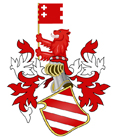Kosace
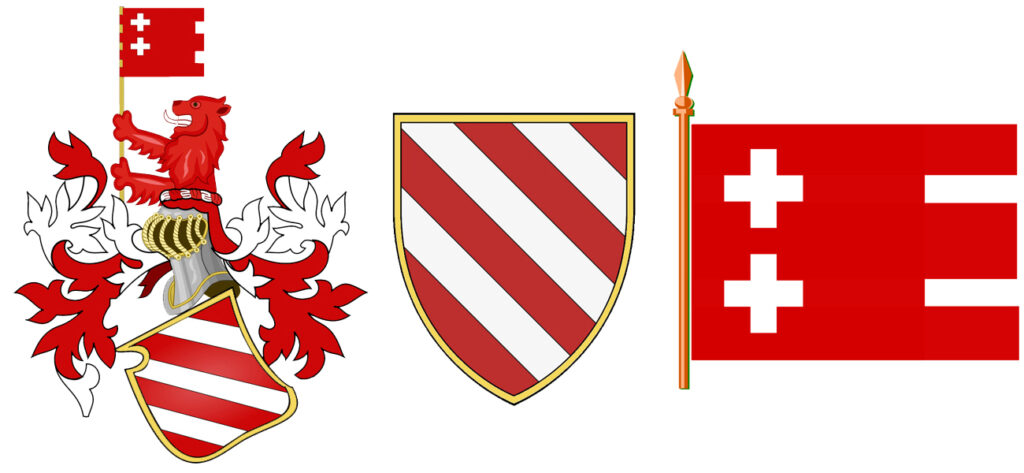
The Serbian ruling family of the Kosaca family ruled the area of Herzegovina and the upper Podrinje in the period from the middle of the 14th century until the end of the 15th century. The ancestor of the Kosaca family was the Serbian duke Vuk Kosaca, the military leader of the Serbian tsar Dusan the Strong. Vuk Kosaca acquired the title of Serbian duke at the court of Serbian Tsar Dusan.
Year of origin of the Kosaca family: 1350
Homelands: Rudine region
Throne: Kosache village and Soko town
Name of the ancestor: Serbian duke Vuk Kosaca
Religious affiliation of the genus: Orthodox Christians
Family members by antiquity:
Serbian Duke Vuk Kosaca
Serbian Duke Vlatko Vukovic Kosaca
Serbian Duke Hrana Vukovic Kosaca
Serbian Duke Sandalj Hranic Kosaca
Serbian prince Vukac Hranic Kosaca
Serbian prince Vuk Hranic Kosaca
Serbian prince Ivan Vukovic Kosaca
Herceg from Saint Sava Stefan Vukcic Kosaca
Serbian Princess Teodora Vukcic Kosaca
Serbian prince Sladoje Vukovic Kosaca
Serbian prince Adam Vukovic Kosaca
Serbian Princess Katarina Vukcic Kosaca
Bosnian Duke Vladislav Hercegovic Kosaca
Herceg from Saint Sava Vlatko Hercegovic Kosaca
Herceg of St. Sava Stjepan Hercegovic Kosaca
Serbian princess Mara Vukcic Kosaca
Serbian prince Marko Vukovic Kosaca
Serbian prince Vuk Vukovic Kosaca
The rule of the Kosaca family lasted for a full 133 years with territorial changes, starting from small estates around the river Drina in the area of Rudina and the village of Kosaca to the whole of Herzegovina and the upper Podrinje. The Principality of Herzegovina was one of the three medieval Serbian states.
The religious affiliation of the Kosaca family was without a doubt the Orthodox Christian faith. This is indicated by historical documents as well as the practice of Orthodox Christian religious customs of the Kosaca family. Before the battle on Kosovo Polje, the army as well as the Serbian duke Vlatko Vukovic Kosaca himself partook of communion in the church of the Holy Archangel Michael in Meka Gruda. The claim is supported by the fact that during his life, the Serbian duke Sandalj Hranic Kosaca erected many monuments, temples and financed many fundraising works. He built a temple-tomb for himself, the church of St. Stephen in Scepan Polje. His nephew, the Duke of St. Sava, Stefan Vukcic Kosaca, was crowned in Mileseva and took the title of Duke of St. Sava. The temples that were built by the Mowers during their rule unequivocally indicate the Orthodox Christian commitment.
Church of St. Stephen on Scepan Polje. Zagrade Monastery with the Church of St. John the Baptist on Scepan Polje, Church of St. George Sopotnica in Kopaci, Monastery of the Assumption of the Blessed Virgin in Dobrun, Savina Monastery in Herceg Novi, Church of St. Sava in Herceg Novi, Church on Podima above Herceg Novi, Church of the Holy Trinity in Kuti above Zelenika, the Church of St. Luke in Smokovac above Risan.
In 1350, the Serbian Tsar Dusan Silni, after occupying most of Bosnia and becoming the master of Bosnia, as a reward for the territories conquered in his wars, granted estates in Rudine, to his Serbian knight, the Serbian duke Vuk Kosaca. After the wars of conquest, the Serbian duke Vuk Kosaca returned to his native estates and formed the ducal family of Kosaca. After returning to his native estates, where he came from, as the son of a small feudal lord, the Serbian duke Vuk Kosaca, he got the whole area of Rudin with the surrounding villages. The duke chooses the village of Kosaca in the valley of the river Drina as the most suitable place for the formation of the capital city. We can freely say that this area was the core of the genus and the impetus for further territorial expansions. In the period from 1350 to 1359, the Serbian duke Vuk Kosaca had two sons, formed the foundations and structure of the Kosaca family.
In 1355, with the death of the Serbian Tsar Dusan and the withdrawal of the army from Bosnia, the Serbian Duke Vuk Kosaca concluded an agreement with the Bosnian Ban on cooperation. The agreement includes the recognition of the title of Serbian duke and the possibility of inheriting the title from descendants. So, after the death of the Serbian duke Vuk Kosaca, the title of the Serbian duke was inherited by his sons, the Serbian duke Vlatko Vukovic Kosaca and the Serbian duke Hrana Vukovic Kosaca.
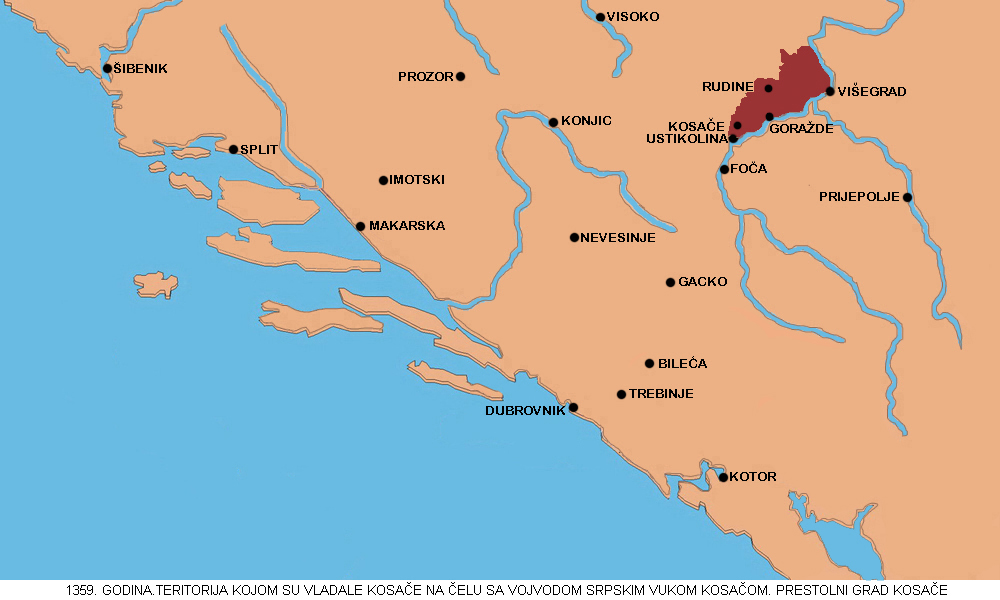
In 1359, the Serbian duke Vuk Kosaca died and his eldest son, the Serbian duke Vlatko Vukovic Kosaca, took his place. He received the well-deserved position of duke at the court of the King of Bosnia and a very independent position in governing his territories. As a very brave and capable knight, the Serbian duke Vlatko Vukovic Kosaca will go to the territorial expansions with the king of Bosnia and conquer them.
In 1373, until 1377, a large expansion of the territory followed, which in the name of the king, but for his own account, was conquered by the Serbian duke Vlatko Vuković Kosača. The extensions went to the east, to the south and to the west. The eastern borders have been extended in the valley of the river Drina in the area all the way to Polimlje and Mileseva. The southern borders were expanded at the expense of Balšić, who took the possessions of Travunija. Expansion of the territory around the river Drina to Brodar. Eastern conquests and expansions took place in Polimlje (Mileseva) all the way to the Lim River. The southern expansion took place in the area of Zeta to the town of Novi and the parish of Dracevica. The principality spread to most of Hum. Sankovići around Konavle and Pavlovići around Trebinje got small territories. Serbian Duke Vlatko Vukovic Kosaca did not expand at the expense of his allies, but expanded his territories in conquests, so that Pavlovic and Sankovic were spared. It enabled them to continue to collect their customs duties in the territories they already owned. The dispute, however, arose over Konavle. Since at the beginning they belonged to the Pavlovićs, who were not able to bring order to that territory, then the duke had to take them and put them under control. This will enable him to rule the area of Konavle, except for one small part which was still ruled by the Pavlovićs. This will result in a conflict with the Pavlovićs in the future. We can freely say that this is the largest extension of the rule of the Kosač clan. After these enlargements, the Principality of Herzegovina takes on its contours, which will be maintained for a long period of time.
The principality of Herzegovina lasted for 133 years, from small estates around the river Drina and the town of Kosača to the whole of Herzegovina and the upper Podrinje.
In 1378, a more peaceful period entered and there would be no significant territorial expansions for the Principality of Herzegovina. Serbian Duke Vatko Vukovic Kosaca will spend that period mostly in negotiations on the handover of the space of Dalmatian cities and the Republic of Dubrovnik. Mostly it will be a combination of negotiations and small war operations.
In 1388, a great battle took place between the army of the Principality of Herzegovina and the Turkish conquerors led by Pasha Lala-Shahin. The conquerors numbered 18,000 soldiers and the army of the Principality of Herzegovina 7,000 soldiers. With their courage and ability, the conquerors were beaten to the feet, so that the pasha himself barely escaped, fleeing with a small group of soldiers. The Turkish invaders suffered a heavy defeat because they hesitated for a long time to attack the Principality of Herzegovina and did not try to do so for 77 years.
In June 1389, the Serbian duke Vlatko Vukovic led the army in the battle of Kosovo Polje as an ally of the Serbian prince Lazar. Before the battle, the army took communion in the church of the Archangel Michael in Meka Gruda. The duke made up the right wing with 7,000 soldiers. The battle ended in a draw because both rulers were killed and the armies withdrew. The Turkish conquerors were made mercenaries and after the death of the ruler, they were afraid that they would not be paid and withdrew. Serbian Duke Vlatko Vukovic Kosaca returned with his army and informed the King of Bosnia and the Pope in the Vatican that the Christian army had won. Because of that, the bells rang in churches all over Europe. The most famous is the Cathedral of Notre Dame, where the bells rang at noon as part of the victory. The Kosača family then became a historical ruling family of European proportions.
In 1390, the duke tried to expand the principality to Dalmatian cities (Split, Trogir, Šibenik and the islands of Hvar, Brač and Korčula) but failed. He was hindered in that by the incursion of the Hungarian army into the Principality of Herzegovina. He had to defend the northern borders and the pressure on Dalmatian cities stopped.
In February 1393, the Serbian duke Vlatko Vuković Kosača died, and since he had no male descendants, the throne of the Kosača family was taken over by his nephew, the Serbian duke Sandalj Hranić Kosača. He inherited the title of duke from his father, Serbian duke Hrana Vukovic Kosaca, and the title came from the ancestor of Serbian duke Vuk Kosaca, who was a commander in the army of Serbian Tsar Dusan Silni, where he deserved the title. The death of the Serbian duke Vlatko Vukovic Kosaca happened immediately after the death of King Tvrtko I in 1391, and the Principality of Herzegovina is moving towards independence and the formation of its system of customs and the army with independent territories.
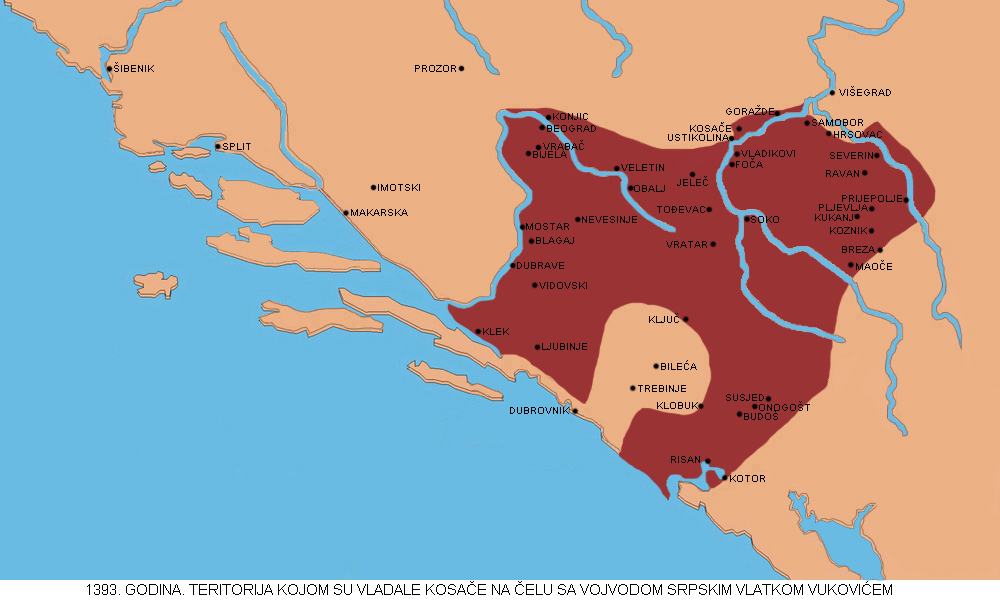
In 1393, the Serbian duke Sandalj Hranic Kosaca took over the throne of the Kosaca family and he will be remembered as someone who stabilized and significantly expanded the Principality of Herzegovina. Serbian Duke Sandalj Hranic Kosaca continues the continuity of the rule of the family with clear characteristics of the Kosaca family, which was enthroned by the ancestor of the Serbian Duke Vuk Kosaca. During the reign of the Serbian duke Sandalj Hranic Kosaca, the Principality of Herzegovina was significantly defined as a state. It defined its trade relations with the Republic of Dubrovnik. It has established four salt outlets in the Sutorina Valley. Strengthened customs points at border points as well as at internal points.
In 1397, with the arrival on the throne of Bosnia of King Ostoja, who forced the Serbian duke Sandalj Hranic Kosaca to release Radic Sankovic. Radic was a prisoner of the Kosaca family for a long time. He was captured and thrown into prison by Serbian Duke Vlatko Vukovic Kosaca. Radic Sankovic was born in Hum and it was estimated that he would take over the territories in the production of Hum from the Principality of Herzegovina. However, that did not happen, and vice versa. All territories and possessions belonged to the Principality of Herzegovina, as well as a house in Dubrovnik with treasure. The period until 1405 will be remembered as a period of turmoil and fortification with the neighbors, as well as the attacks of the neighbors on the territories of the Kosaca family. The Serbian Duke Sandalj Hranic Kosaca, who had Serbian diplomacy and military skills, will help save the Principality of Herzegovina.
In 1405, there was a significant stabilization of the Principality of Herzegovina, led by the Serbian duke Sandalj Hranic Kosaca. It completely defines and significantly expands the principality in the north towards Hungary and the city of Srebrenica. He occupies the fortress of Durdevac on the banks of the river Drina. So that he sets the defensive line of the Principality of Herzegovina on the banks of the river Drina.
In 1406, the principality expanded to the towns of Slunj, Dreznik and Cetin. Due to the weakness of Hrvoje Vukcic and his inability to control his territories, the Principality of Herzegovina took over his estates and cities. Until then, the Principality of Herzegovina was a good ally of Hrvoje Vukcic’s family, but due to his weakness and defeat in the war with Hungary in the north, his country weakened and became easy prey. The marriage of the Serbian duke Sandalj Hranic Kosaca with Katarina Vukcic Sinovic Hrvoje, made it possible for the Serbian duke Sandalj Hranic Kosaca to feel comfortable and take over the territories of the Vukcic family.
In March 1407, the principality expanded to Ostrvica and Skradina. Then the war between the Principality of Herzegovina and Hungary over the city of Srebrenica began. The war will bring great destruction of the territories ruled by Hrvoje Vukcic because he was defeated with the Kingdom of Bosnia. The Principality of Herzegovina entered into negotiations with the Hungarian king and gained parts of the city of Srebrenica. The Kingdom of Bosnia and Hrvoje Vukcic did very badly in those negotiations because Hungary appropriated the northern territories.
In 1411, a peace agreement was defined due to the war with Hungary over the city of Srebrenica. It was agreed to share resources in the city. The trade is divided into equal parts.
In 1412, a war conflict with Kotor began. The principality was constantly trying to take the city of Kotor and the coast. In this he was an ally of Balsha III. The marriage of the Serbian duke Sandalj Hranic Kosaca and Jelena Lazarevic was also political because the two ruling families became allies. The war campaigns in Kotor ended with a peace agreement where Kotor was defeated and promised to pay 12,000 ducats as a vassal subject. The Principality of Herzegovina became an ally of Hungary and took part in the wars against the Turkish invaders. The result of the negotiations over the city of Srebrenica resulted in an alliance. After a great conflict between the Hungarian army and the Turkish invaders, the Hungarian army was defeated and after that the pressure of the Hungarian army on Hum and the Principality of Herzegovina stopped.
In 1412, the Principality of Herzegovina was represented at the knights’ tournament in Buda as an independent state, and the Serbian duke Sandalj Hranic Kosaca and his wife Jelena Lazarevic Kosaca were presented as a royal couple. The knights’ tournament was organized on the occasion of the reconciliation of the Hungarian king Sigismund of Luxembourg and the Polish king Vladislav Jagel. Serbian Duke Sandalj Hranic Kosaca was a very intelligent ruler. Very energetic and mobile by nature. He often licked his country and was always well informed. At the knights’ tournament in Buda, he shared information about medieval Europe and introduced himself as a very informed ruler. He paid Dubrovnik sailors to bring him information around the world.
In 1415, the murder of Pavle Radinovic, who ruled Trebinje and its surroundings, took place. Serbian Duke Sandalj Hranic Kosaca and his younger brother, Serbian Prince Vuk Hranic Kosaca, were involved in that murder. It was an attempt of the Principality of Herzegovina to take over the territories from Pavlović. It was partially successful. The town of Ustikolina with Cvilin polje passed into the hands of the Kosaca family. The Pavlovics still kept other territories under control.
In 1419, the process of selling Konavle took place and the surroundings of Dubrovnik. A large part of Konavle, which was ruled by the Kosaca family, was sold there for money. It was sold to Dubrovnik with great benefits. The ruling Kosaca family received a palace in Dubrovnik with the right to citizenship of the family in the state of the Republic of Dubrovnik.
In 1420, the Principality of Herzegovina sold Drijevo and the town of Kotor to the Venetian Republic. After that, the borders of the Principality of Herzegovina were moved. Pressed by the great conflicts that brought with them costs, the clan decided to sell some territories so that they could pay the army.
After 1420 until the death of the Serbian duke Sandalj Hranic in 1435, a more peaceful period began. There were no major changes in the territories of the Principality of Herzegovina. Most of the trade processes took place. Diplomatic activity was strong and dominant. Serbian Duke Sandalj Hranic Kosaca did not have the title of king, but he had that rank in the eyes of other kings.
In 1422, a trade dispute broke out between the Principality of Herzegovina and the Republic of Dubrovnik. Dubrovnik was angry because Drijevo and Kotor were sold to the Venetian Republic. This jeopardized their interests in selling salt.
In 1423, the Principality of Herzegovina sold the town of Sokol in Konavle. The sale process was completed by handing over the city of Sokol to the Republic of Dubrovnik. This begins the process of withdrawing the Kosaca family from the area of Konavle.
In 1424, there was a major attack by the Turkish conquerors on the Principality of Herzegovina. These attacks caused great destruction and devastation. Nevertheless, the Principality of Herzegovina defended itself and recovered from these attacks.
In 1426, a diplomatic visit of the Principality of Herzegovina to Dubrovnik took place. It happened on the feast of St. Blaise. 02/02/201426 and 03.02.1426. years.
In 1427, the capitulation of the Kingdom of Bosnia took place and it became part of the Hungarian state with the administration of Herman of Celje. The Principality of Herzegovina is one of the witnesses to the surrender.
In 1430, the first war broke out in Konavle. Radosalv Pavlovic attacked Dubrovnik and caused great damage to the surrounding villages of the Dubrovnik Republic. The Principality of Herzegovina was a mediator in that war. She served as an intermediary. Due to the defeat of Pavlović that followed, the Kosaca family took over the town of Klobuk and its surroundings.
In 1432, peace was achieved between the Pavlović family and Dubrovnik. Negotiations took place in the fortified town of Kukanj. The Principality of Herzegovina was the mediator of the conclusion of peace. The Pavlovics never recovered after that.
In March 1435, the Serbian duke Sandalj Hranic Kosaca died and his nephew, the Duke of St. Sava Stefan Vukcic Kosaca, ascended the throne of the Kosaca family. He was immediately under great pressure and attacks. The enemies of the Principality of Herzegovina were waiting for an opportunity to attack.
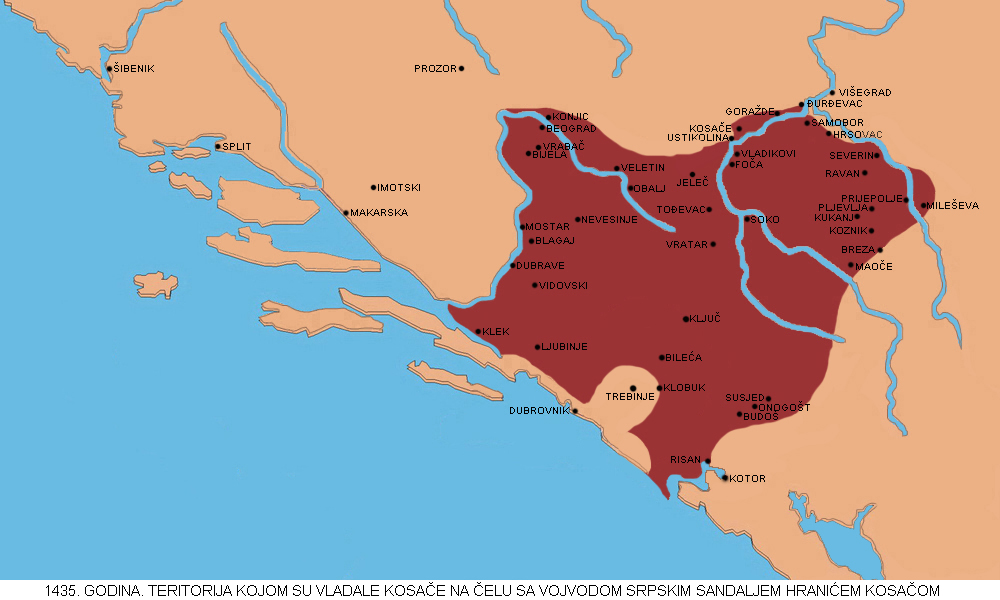
In 1435, the Hungarian king Sigismund of Luxembourg, with the help of his vassal King Tvrtko II, launched an attack on Hum and Drijeva because it was a large trade center. The Pavlovics, long-time enemies, also joined them in the attacks. Attacked from all sides and in a very unenviable position as the Principality of Herzegovina found itself, the duke resorted to a business move. Due to the large number of opponents, he resorted to hiring a mercenary army. It was a move that defeated the invaders and gave the opportunity to expand the principality on top of everything else.
In 1346, the Principality of Herzegovina expelled the Hungarian king from Hum. She defeated the Bosnian king as well as Pavlović. Due to these victories, the Principality of Herzegovina received confirmations from Dubrovnik and the Venetian Republic as an independent state. He made a peace treaty with King Tvrtko II. However, it remained in a silent conflict with the Pavlovics until the death of Radoslav Pavlovic.
In 1437, the Principality of Herzegovina attacked the territories of the Pavlovics and occupied the town of Trebinje, Klobuk and other territories ruled by the Pavlovics. Pavlovic’s country was devastated and looted after those attacks. That was the beginning of the decline of the power of the Pavlović family.
In 1439, the Turkish invaders attacked the Principality of Herzegovina again. Under these blows, the principality was weakened and forced to withdraw from the territories occupied by Pavlović. In order to reach a truce with the Pavlovic family, the Duke of St. Sava, Stefan Vukcic Kosaca, married his Serbian princess Teodora Vukcic Kosaca to Radoslav Pavlovic.
In 1440, the Pavlovics got into financial trouble and due to the financial debt to the Turkish conquerors, they were left without defense. It is used by the Principality of Herzegovina and re-occupies Trebinje, Klobuk and the territories around Trebinje.
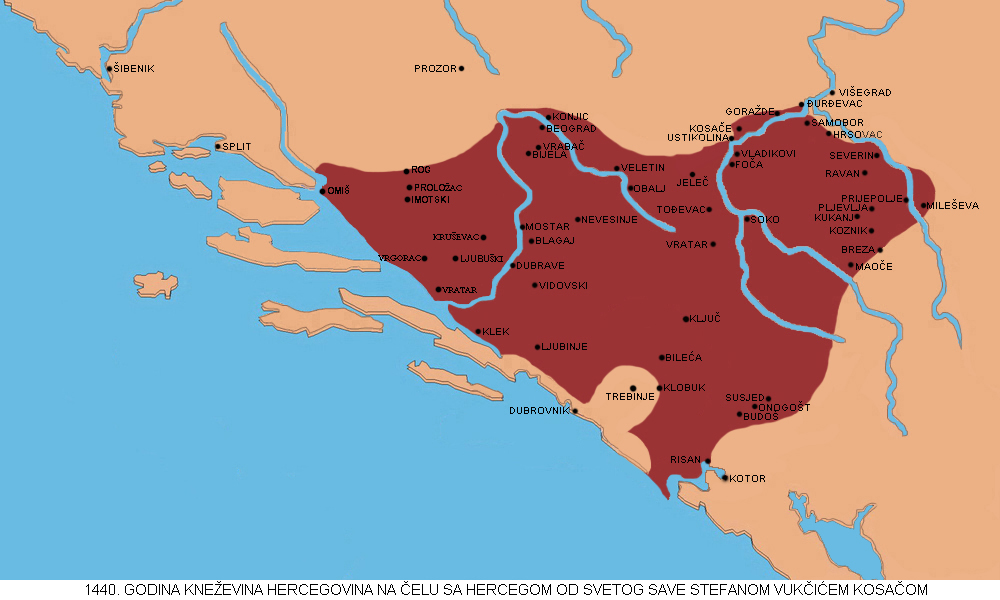
In 1441, the Principality of Herzegovina attacked Zeta. It occupies Gornja, which was ruled by the Crnojevics. The great expansion of the Principality of Herzegovina is happening again on the historical scene. The extensions were directed towards the sea and the sea shore. The Upper Zeta was easily occupied, but it was harder with the Lower Zeta, because the Venetian Republic was very strong.
In 1442, the Principality of Herzegovina attacked Kotor and the lower Zeta, but it was not easy. The Venetian Republic strikes back. The Kosača family on both sides of the war also joined the fight. Serbian prince Ivan Vukovic Kosaca is trying to overthrow his brother from the uncle of the duke of St. Sava Stefan Vukcic Kosaca with the help of the Venetians. However, he does not succeed and the duke remains on the throne. The army of the Principality of Herzegovina captured the city of Bar, while Budva and Drivast surrendered to the Venetian Republic. The principality also lost the town of Omis and its surroundings.
In 1444, the Kingdom of Bosnia invaded the Principality of Herzegovina and occupied Drijevski Square. In the east, Djuradj Brankovic, as a vassal of the Turkish conquerors, attacks and captures the city of Srebrenica. So the principality loses the city of Srebrenica and the area around it.
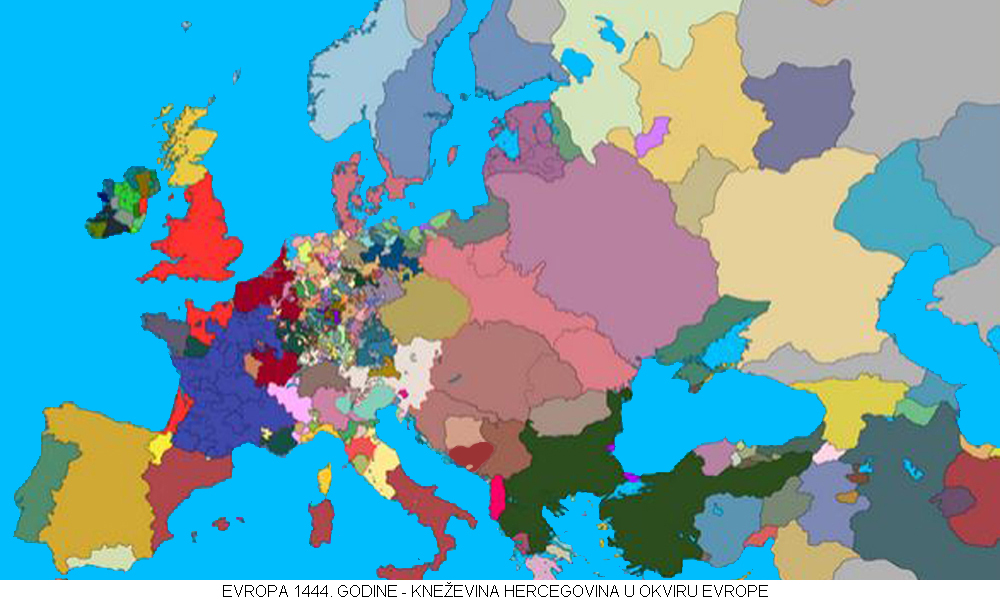
In 1446, a political marriage took place. The king of vassal Bosnia, Stjepan Tomas, and the Serbian princess Katarina Vukcic Kosaca are getting married. The reason for the marriage was to calm down the situation between the Principality of Herzegovina and the Kingdom of Bosnia. Serbian Princess Katarina Vukcic Kosaca then renounced the Orthodox Christian faith and accepted another faith. Educated in the Orthodox traditional spirit, the princess changed her religion and became the queen of Bosnia.
In 1448, the Principality of Herzegovina, together with Tom Kantakuzin, attacked Srebrenica and occupied it. This will make his son-in-law the king of Bosnia very angry, but the kingdom is very weak then and has no strength to answer.
In 1450, the Duke of St. Sava, Stefan Vukcic Kosaca, was crowned in the Mileseva Monastery. Like all Serbian rulers, he continues the tradition of coronation in Mileseva. He became a duke of Saint Sava, and officially no longer had anything to do with the Kingdom of Bosnia. He was crowned in the Serbian Orthodox Church and received the title consecrated by the Serbian Orthodox Church. It all tells us about his religious affiliation. The first step he took as a duke and independent ruler was that, he opened new saltworks and squares with the sale of salt in Sutorina. He opened weaving mills in Novi Grad and planned to turn the city of Novi, a large seaport. This provoked the anger of Dubrovnik, which banned all trade on his land. Nevertheless, he managed to maintain trade with Venice. He still sold silver, lead and wax and bought fabrics.
In 1451, the second Konavle war broke out because the dissatisfaction of Dubrovnik was great due to the commercial arbitrariness of the duke. The great financial damage that it caused to Dubrovnik, that it could no longer be endured. That year was supposed to be the wedding of the duke’s eldest son to an Italian woman from Siena. In that period, the arbitrariness of the duke comes to full expression and he takes for himself the girl intended for the wedding of his eldest son. His son and wife enter into an alliance with Dubrovnik, Petro Vojsalic and others against him. All of them together attack the Principality of Herzegovina and it then significantly loses territories. Herceg’s son Vladislav Hercegovic became the Bosnian duke and attacked his father’s country. It occupies large territories of Hum, cities in the Neretva valley, Vratar, Todevac and even Jelec. His son-in-law, King Stjepan Tomas, also joined him in the attacks. At that moment, the principality was in an unenviable situation, but due to the conflict between the allies themselves, the duke used it and expelled them all from their territories.
In 1453, the Duke’s wife Jelena Balsic died.
In 1454, peace was made with Dubrovnik, where it was planned to return to the previous state. The territories it had before the war were returned to the Principality of Herzegovina.
In 1455, the duke married a second time, with his wife Barbara De Payo. From that marriage, three children were born, Mara Hercegovic Kosaca and Stjepan Hercegovic Kosaca. The third child died very early and there is no information about his name. In the same year, his son Vladislav Hercegovic Kosaca married Ana Kantakuzin. Vlatko Hercegovic Kosaca also married him to Margarita, the daughter of Urlih Celjski. That year was full of a lot of weddings.
In 1458, peace was made with vassal Bosnia, where Bosnia also returned the conquered territories. The Principality of Herzegovina recovered from the war and regained its territories. However, the arbitrariness of the duke continued, and with that the dissatisfaction of his son, the Bosnian duke Vladislav Hercegovic Kosaca.
In 1459, the Turkish conquerors invaded the Principality of Herzegovina and conquered the northern territories. The towns of Srebrenica, Zvornik and Teocak were occupied. These are the first signs of significant and permanent occupation of the territory by the Turkish invaders. Instructed by the team, the Duke of St. Sava, Stefan Vukcic Kosaca, writes to Venice that the time is coming when the Turkish conquerors will devour all rulers and territories.
In 1461, there was a new attack on the Principality of Herzegovina by the Bosnian duke Vladislav Hercegovic Kosaca. The clashes lasted until the duke’s death. Vladislav spent that period in Dubrovnik. As early as mid-March 1462, the conflict flared up. The reason for the conflict was the dissatisfaction of the Bosnian duke. Herceg promised to give his son three towns, Ostrog, Susjed and Budos, to manage. The Duke of Bosnia, Vladislav Hercegovic Kosaca, asked for the help of the Turkish conquerors in the war with his father and promised them 100,000 ducats if they would help him in the attack. They attacked the duke’s land because they were essentially mercenary robbers and fought for profit.
In 1463, the first attack took place. The Turkish invaders divided the army into three columns. Part of the army was given to Vladislav to attack his father and the Principality of Herzegovina on Breznica. In that battle, the principality was defeated. Turkish invaders entered Bosnia in the town of Ustikolina on the river Drina. They entered in three columns. One column went north to stop the Hungarian army. The middle column went to Bosnia and Jajce to be occupied by vassal Bosnia, and the southern column was given to Vladislav to defeat the Principality of Herzegovina. The shameful move of the duke’s son led to the beginning of the end of the Principality of Herzegovina. He is herceg therefore expelled him from his will, claiming that he had brought the Turkish conquerors to Herzegovina. After these conquests, the places were looted and deserted. The leadership of the army of the Principality of Herzegovina is taken over by the younger son, the Duke of St. Sava Vlatko Hercegovic Kosaca, who gradually cleans the cities and brings them back under control. In mid-October, everything was returned under control, so even the cities under Pavlović’s control were occupied. A small town near Srebrenica is also occupied. The Sultan was angry that the city of Kljuc was conquered because of the duke and not because of the Hungarian army.
In 1464, a meeting of members of the Kosaca family took place with the aim of removing the duke from the throne and dividing the country. In the whole process of removing the duke, Vladislav included his brother from the uncle of the Serbian prince Adam Vukovic Kosaca, who was interested in taking the lead in the northern territories in the valley of the upper course of the river Drina and the town of Foca. These negotiations took place in Dubrovnik. In the end, an agreement was reached between the Duke of Saint Sava, Stefan Vukcic Kosaca, and the Duke of Bosnia, Vladislav Hercegovic Kosaca. Bosnian Duke Vladislav Hercegovic Kosaca received 1/4 of the territories that belonged to the duke. Unfortunately, there was a new invasion in 1464 by the Turkish conquerors. The younger son of the Duke of St. Sava, Vlatko Hercegovic Kosaca, was wounded and took refuge in the territory of the Republic of Dubrovnik in order to be treated and recovered. This time there was enormous destruction and devastation from which the Principality of Herzegovina never recovered.
In 1465, there was a new attack by the Turkish invaders, where the northern cities under the leadership of the Serbian prince Ivan Vukovic Kosaca, such as Samobor, Foca, Gorazde, Ustikolina, were devastated. During the attack on Foca, Serbian prince Sladoje Vukovic Kosaca was also captured. After that, his man Radin paid money in Dubrovnik for the prince’s freedom and ransom. Herceg retreats to the southern territories of Sutorina and Novi, where he spends his last days. Bosnian Duke Vladislav Hercegovic Kosaca with his sister the Queen of Bosnia Katarina Kosaca Kotromanic is hiding from the Turkish invaders on the island of Mljet. At his invitation, the Turkish invaders came, but they deceived and attacked him and then defeated him. Aware of his defeat, he tries to hide and save his family and naked life.
In 1466, the duke of St. Sava, Stefan Vukcic Kosaca, died in the town of Novi. In his will, he leaves the land to his sons to rule. Duke of Bosnia Vladislav Hercegovic Kosaca became a Venetian vassal and took control of the towns of Mali and Veliki Klek. Herceg from Saint Sava Vlatko Hercegovic Kosaca received the management of a small territory around Sutorina and the town of Novi. At that time, the Principality of Herzegovina was only in that small area. He managed to maintain himself with political skill until 1483. Herceg from Saint Sava Vlatko Hercegovic Kosaca concludes an agreement with Hungary and the Venetian Republic on the protection of the Principality of Herzegovina in exchange for money.
In 1483, there was the last attack of the Turkish conquerors led by his younger brother Stjepan Hercegovic Kosaca as a Turkish vassal. Then the duke was defeated and the Principality of Herzegovina ceased to exist. Herceg from St. Sava Vlatko Hercegovic Kosaca retreated to the island of Rab where he died in 1489. Thus, after 133 years of existence from small estates around the river Drina and Kosaca to the whole of Herzegovina and the upper Podrinje and again all the way to small estates in the Sutorina valley, the Principality of Herzegovina survived and left its historical trace in the Balkans and Europe. Leaving behind the culture of Christian Orthodox civilization, historical temples, places of worship and historical documents. It can be said with certainty that it had its own peculiarities and characteristics. It was from three medieval Serbian states. As a descendant of the Kosaca family from this time distance, I am very proud of the tradition left behind by the Principality of Herzegovina. The Principality of Herzegovina still lives in our hearts.
